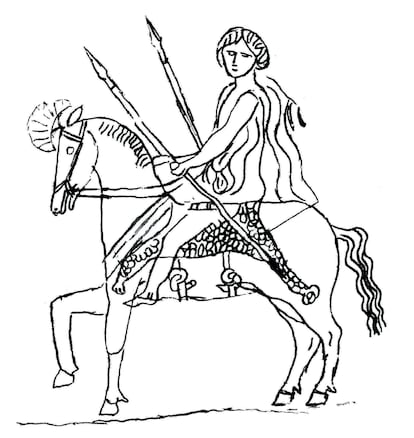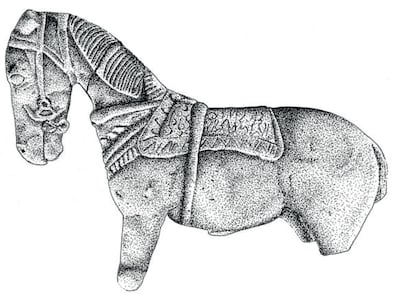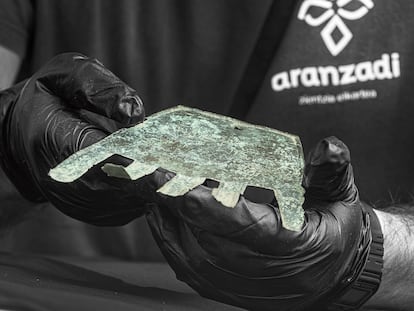Study sheds light on mysterious mounted warrior from Africa who fought the Roman legions
A revised analysis of a horseman’s portrait found in southern Spain suggests he may have helped kill Publius Cornelius Scipio, the famous general who fought Hannibal in the Second Punic War


The Punic Wars were a series of three fierce conflicts fought between 264 and 146 BC by Rome and Carthage over control of the western Mediterranean. The Iberian city of Cástulo, near present-day Linares, in Spain’s southern Andalusia region, was one of the backdrops to the struggle, the Iberian peninsula being the main stage for the first phase of the Second Punic War, which also saw Hannibal’s crossing of the Alps and the invasion of mainland Italy.
In charge of the Carthaginian troops was general Hasdrubal while the Roman armies were led by the brothers Publius and Gnaeus Cornelius Scipio. In 1976, at the necropolis of Estacar de Robarinas, a slate plaque engraved on both sides was found in what appeared to be the destroyed tomb of a warrior. On one side of the plaque there was a horseman holding two spears, mounted on a horse saddled with a leopard skin.
A new study titled An African Horseman in Cástulo by Sabino Perea Yébenes, a professor of ancient history at the distance learning university UNED, suggests the portrait is a representation of a North African horseman who fought in Cástulo, one of those whose spears mortally wounded Publius Cornelius in 211 BC, according to ancient sources. The study was published in Rivista della Scuola Archeologica Italiana di Cartagine.
The fearsome African cavalry, composed of Numidians and Mauritanians, played a significant role in this war. It is an established fact that as soon as Hannibal arrived in the Iberian Peninsula, he asked Carthage to muster African cavalry to defeat the Romans. He was sent a contingent of 1,800 men, who went into action in 215 BC and fought against Rome together with Iberian and Punic (also known as western Phoenician) warriors. Perea notes that these cavalrymen “got right into the thick of the fight by jumping between horses.” Four years later, their fighting skills forced Publius Cornelius Scipio to take refuge in Cástulo and his brother Gnaeus to escape to a fortified tower in Orso – present-day Osuna, Seville – which his enemies set on fire, burning him to death.
When Hannibal set course for Italy, he left his brother Hasdrubal at the head of the Hispanic army “with many ships and troops consisting of Iberians and Africans.” According to the Roman historian Titus Livius (or Livy), who wrote an account of the Second Punic War in his History of Rome, there were a total of “11,850 infantrymen from Africa, 300 Ligurians and 500 Balearics; and, as reinforcement to the infantry, 450 Libyophenician cavalrymen, a race half Phoenician half African, and up to 8,000 Numidians and Moors from the shores of the Ocean.”

The horseman’s portrait was found broken into four pieces in a necropolis dedicated exclusively to warrior tombs, a place where numerous swords and daggers were also found. All weapons had been ritually folded or broken to prevent second use. The slate – a square 18 centimeters on each side – was in a “terrible state, very fragile.” Archaeologists who found it in 1976 thought it was the work of a local artist who had copied a drawing from a Greek vase. However, in 1983, the historian Antonio Blanco Freijero analyzed the piece and interpreted it, this time, as an “Iberian horseman”, not a North African one. It was not studied again for the next 40 years “despite its unquestionable interest,” says Perea.
However, the new study points out that it is neither a “Turdetan prince nor a local aristocrat fond of hunting, as Blanco Freijeiro suggested, but an African warrior, one of the many who participated in the wars waged in the Iberian peninsula in the early phases of the Second Punic War.” The image, being “framed” between two vertical lines and one horizontal line, can be considered the “individual portrait” of a warrior who “is posing, since the horse is standing still, with its right leg elegantly raised. The same goes for the rider, who shows a calm demeanor. He is not in combat, nor parading, but allowing himself to be portrayed.”
The rider looks straight ahead at the viewer, an unusual perspective, says Perea Yébenes. It is also an improvised drawing, since some of the strokes present rectifications. Still, in its simplicity, it “reflects quite a bit of technical skill, with great concern for displaying detail.” The rider is lightly dressed, as can be seen on the blackboard, with a wide, billowing cloak and a short tunic or chlamys. The legs, arms and feet are bare. The head shows a mane knotted behind. The hands are holding two spears, characteristic weapons of Africans, Mauritanians or Numidians.
The horse’s head is almost completely missing and only the muzzle and part of the reins remain. It is well drawn “with almost perfect proportions.” His saddle is a leopard skin, as evidenced by some spots and the visible claws on the limbs. The saddle does not have stirrups, since they were unknown in Roman times. What the horse did carry was a headpiece on its head to place a decorative plume.

The spears held by the horseman in the portrait were very appropriate in his homeland, notes the study, since they consisted mostly of flat areas, “where this type of warrior moved with three spears and stones in leather bags.” They did not use swords, helmets or any other type of weaponry, “since their objective was to excel with the agility of movement in the pursuit and then in the retreat. The points of their javelins could be impregnated with poisonous substances.” For this reason, the African horsemen never formed a shock force, because their tactic consisted of dashing towards the enemy until they came within a few meters of them, throwing their javelins, and then withdrawing. Their objective was to provoke skirmishes and to chase down enemies in disarray.
Therefore, says the researcher, “the rider from Cástulo is undoubtedly African.” Perea dates the plate to the late 3rd century BC and believes that the warrior reflected in it “possibly was one of those who besieged the fort of Cástulo, in Roman hands since the summer of 212 BC.” “During the siege”, continues the author, following the story chronicled by the Roman historian Livy, “when the Romans were on the verge of victory, Masinissa’s Numidian cavalry arrived, managing to tip the scales in favor of the Carthaginians, killing Scipio, who died near Cástulo, in one of the skirmishes, when an [enemy] spear was stabbed into his thigh, causing a mortal wound.”
A spear thrown by a Numidian horseman like the one in the portrait? “It’s possible.”
Sign up for our weekly newsletter to get more English-language news coverage from EL PAÍS USA Edition
Tu suscripción se está usando en otro dispositivo
¿Quieres añadir otro usuario a tu suscripción?
Si continúas leyendo en este dispositivo, no se podrá leer en el otro.
FlechaTu suscripción se está usando en otro dispositivo y solo puedes acceder a EL PAÍS desde un dispositivo a la vez.
Si quieres compartir tu cuenta, cambia tu suscripción a la modalidad Premium, así podrás añadir otro usuario. Cada uno accederá con su propia cuenta de email, lo que os permitirá personalizar vuestra experiencia en EL PAÍS.
¿Tienes una suscripción de empresa? Accede aquí para contratar más cuentas.
En el caso de no saber quién está usando tu cuenta, te recomendamos cambiar tu contraseña aquí.
Si decides continuar compartiendo tu cuenta, este mensaje se mostrará en tu dispositivo y en el de la otra persona que está usando tu cuenta de forma indefinida, afectando a tu experiencia de lectura. Puedes consultar aquí los términos y condiciones de la suscripción digital.
More information
Archived In
Últimas noticias
There is as much life left to discover on planet Earth as that which is already known
Dozens presumed dead, around 100 injured in fire at Swiss Alps bar during New Year’s celebration
Is porn for women different from conventional porn? We spoke to those who make it
Cartagena de Indias is sinking: What can the city do to mitigate it?
Most viewed
- Reinhard Genzel, Nobel laureate in physics: ‘One-minute videos will never give you the truth’
- Sinaloa Cartel war is taking its toll on Los Chapitos
- David King, chemist: ‘There are scientists studying how to cool the planet; nobody should stop these experiments from happening’
- Oona Chaplin: ‘I told James Cameron that I was living in a treehouse and starting a permaculture project with a friend’
- The Interoceanic Train, the Mexican alternative to the Panama Canal










































